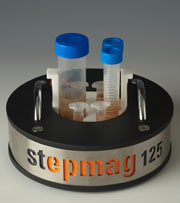Biomagnetic separation systems (BMS) have been developed over the past decade to offer flexible alternatives to a large number of lab techniques. Lluis M. Martinez, SEPMAG, reviews its growing contribution to therapeutics and diagnostics.
The principle behind biomagnetic separation (BMS) is the action of a magnetic force on particles. Even a simple block magnet can exert some degree of force onto the contents of a nearby test tube, changing their distribution within the tube. The process of refining this with improved orientation of the magnets and fluid to be separated has given way to the powerful and effective SEPMAG magnetic separation products available on the market today.
Ensuring appropriate separation requires the correct magnetic field pattern (i.e. distance from the magnet) – too strong a magnetic force and the particles aggregate, but too weak and they behave too independently. Creating a uniform magnetic force was a key hurdle to overcome. Before the magnetic force was made uniform, capacity was limited to 50ml. Now several litres can be handled, making BMS applicable to commercial production processes.
Further concerns were raised about the safety of the old generation of magnetic machines, with injuries reported and possible interference with nearby pacemakers, computers or magnetic recording devices. These obstacles presented significant challenges to the development of BMS, such that non-magnetic separation research became increasingly popular, in the hope of providing a realistic alternative.
These obstacles were addressed in 2004, through international collaboration and discussions, which resulted in the successful and intrinsically safe scaling up of the process with the additional benefit of a reduced separation time.
This impressive work was further built upon by subsequent dialogues among a number of global in vitro diagnostics (IVD) companies. This resulted in a change in the definition of the BMS process, since newly developed parameters allowed for greater analysis. Defining the operating conditions and separation time provided additional support for developing SOP (standard operating procedure) and Quality Assurance protocols, both important milestones in a product’s journey to the marketplace.
The applications of BMS, although varied, fall into two rough categories; those using it for in vitro procedures and those applying it to in vivo scenarios.
The four main areas of in vitro applications of BMS – immuno/molecular diagnosis, protein purification, cell and nucleic acid separation1 – all have a common criterion: the isolation of a valid and intact biological structure, be that a cell, DNA or a protein.
diagnostics
Immuno-diagnostics is a major field in healthcare and is also used as a quality control tool in industry. Opportunities are increasing in line with better understanding of pathogenic mechanisms, leading to the possibility of more disease markers and tests. Another significant diagnostic market is testing for food allergens.
For detecting antibodies or antigens there are a number of different diagnostic techniques available: ELISA (Enzyme-linked Immuno-sorbent Assay), IEP (Immunoelectrophoresis), EITB (Enzyme-linked Immuno-electrotransfer Blot) and agglutination studies.2 ELISA is used to detect HIV and West Nile disease serum levels. The enzymes that are central to ELISA have been replaced in some systems by fluorogenic, electrochemiluminescent and real-time PCR reporters to create quantifiable signals that are more sensitive and have the capacity to measure several analytes in the same assay.3
However, BMS systems such as SEPMAG’s ‘Stepmag’ measure up well against the alternatives because they generate highly reproducible quantifiable results – an essential criterion for clinical IVD kits (see Figure 1).
Molecular Diagnostics has an equally important role in clinical disease management, by way of detecting pathological processes. For example, molecular cytogenetics is important in diagnosing and managing CML (chronic myeloid leukaemia), and gene rearrangement is an important element of lymphoma studies.4 The current portfolio of techniques includes PCR (Polymerase Chain Reaction), FISH (Fluorescent in situ hybridisation), DNA micro-assays and karyotype imaging.5 BMS can provide quick and accurate alternatives to these techniques, and applies to a range of molecules including important disease markers and pharmaceutical compounds.
protein separation
To study the function, structure and interactions of proteins from the common starting point of a tissue or microbial culture, the protein in question needs to be purified. Scientists have long known that enzymes are complex protein structures, so being able to study them opens the door to understanding the molecular mechanism of life within a cell. Proteins also serve as drug targets and disease markers and as therapeutic agents in themselves.
Different techniques purify proteins based on the varying characteristics of the proteins – current methods include high performance liquid or reverse phase chromatography, SDS-PAGE and ion exchange columns, with Western Blotting, ELISA or BMS suitable for proteins without known antibodies.6 In the face of high exposure levels and the presence of particulates, BMS systems such as SEPMAG Lab can effectively separate proteins. Because the filtration, centrifugation and clarification stages of conventional separation are not needed when using BMS, more protein can be recovered from the original suspension than is possible using conventional methods. A study of an oncogenic enzyme factor demonstrates the advantages of BMS7: the mapping of the epitope of carbonic anhydrase, an enzyme linked to tumour growth, was made possible by the rapid and effective separation by BMS. This degree of effective purification allows for downstream processing or study of proteins – an important component of pharmaceutical research, development and production (see Figure 2).
cell separation
Batches of homogenous cells are a valuable resource for research into stem cells, genetic engineering, gene expression profiling, pathogenic mechanism of diseases such as cancer and foetal medicine. Since some of these cells are rare, their capture can be challenging.
There are important factors to consider when choosing techniques: the function of the cell in question must be retained if subsequent cellular analysis is to be made. Lymphocyte cell function was found to decrease with both the sheer force slide and commercial stomacher techniques of separation, but not with metallic or plunger screen methods.8 Possible mechanisms include using natural cell surface markers of cell types or treating the cells with enzymes as in flow cytometry.
Another technique has been developed based on the opposite principle – negative selection. Laser-mediated removal of unwanted cell types leaves a high yield of wanted cells (even from a low starting number). Magnetically mediated techniques are based on similar principles, but with the added advantage of the cells retaining more of their function. Magnetic separation can also be used to positively select cells (based on cell surface characteristics). Since SEPMAG’s systems can use crude samples such as blood, bone marrow, tissue homogenates, stool, cultivation media, food, water and soil, a range of specific cell types can be captured.9
The capture of specific cells then opens the doors for further investigation or diagnosis; for example, cultivation of cells and tissues for analysis of intercellular components.
nucleic acid separation
Nucleic acid based testing for genetic diseases is becoming increasingly important, and small genetic traces such as foetal genetic material in maternal blood could provide doctors and researchers with valuable information. Gene expression studies often require time-consuming amplification stages, so a number of alternative techniques have been developed that can bypass these stages.
Hybridisation probes can be used in complex mixtures, but use is limited by low specificity and sensitivity. This is often an issue, since there is a lot of contaminating RNA and protein in cells and complex mixtures. Eliminating non-specific binding can help this – using complementary strands to make inert non-target sections.
Silica beads have been used in DNA capture before, because of their adsorbent properties, and combining this with magnets has further improved the process.10 mRNA capture can also be achieved using magnets: the process is based on the hybridisation of Poly (A) mRNA sequences covalently linked to paramagnetic particles.
For a complete picture, since epigenetics are becoming central to our cellular understanding, nucleic acid binding molecules can be collected using magnets. The targets of these molecules are bound to magnetic beads for the indirect capture of any interacting molecules.11
The flexible adaptation of magnetic technology to these different capture techniques allows researchers to gain a valuable insight into every genetic aspect within living cells.
future potential
The progress made so far with BMS looks set to continue with a range of potential uses already in the pipeline. Many of these focus on therapeutic in vivo uses.
Nucleic acids can already be captured – the next step is to transfer them, as foreign genetic material, into cells, targeting them towards specific cells with magnets. This can increase transgene expression levels by up to three orders of magnitude, increasing efficiency.12 Viral-mediated gene delivery could also be made more efficient with magnet particles for guidance towards appropriate cells.13 This has potential applications in bacteriology, pharmaceutical r&d and genetic studies.
Delivery of pharmaceutical molecules can be magnetically mediated. For example, drug eluting stents used in patients with vessel occlusion are good, but only one dose of the antiproliferative drug can be administered. Attaching the drug to biodegradable magnetic nanoparticles allows additional doses to be accurately administered.14

End-users often need to work with a wide range of volumes, starting with small tubes and increasing sample size when processes are optimised or simply when sample volumes vary
Magnetically-Mediated Hyperthermia15 (MMH) is a possible physical therapy for cancer. Magnetic forces accumulate magnetic particles in a localised region of tissue and heat up the tissue, killing only the temperature-sensitive tumour cells. The specificity of thermal effects on tumour cells is associated with reduced side-effects.
Magnetic-force based tissue engineering16 allows cells (magnetically labelled) to be organised into 2D and 3D multi-layered structures using magnetic forces. Studies have already used magnetic-based techniques for a range of tissues from umbilical veins to retinal pigment epithelial cells and cardiomyocytes to mesenchymal stem cells.17
Biomedical research is a rapidly expanding and invaluable area of modern healthcare. With demands for diagnostic tests and increased pathophysiological knowledge at a constant high, developing techniques to aid their research is critically important. Biomagnetic separation systems such as those from SEPMAG have developed over the years to offer a legitimate and flexible alternative to a large number of lab techniques. The contribution made by BMS to increasing biomedical knowledge could prove very significant in the coming years, as potential applications emerge from research to the reality of labs across the world.
references:
1 J L, Corchero and A Villaverde, 2009. Trends in Biotechnology, Vol. 27 (No.8)
2 M H Kaddah, et al, 1992. Egypt Society of Parasitology, 22(3):653-65
3 M Adler, S Schulz and M Spengler, 2009. Chimera Biotech. (Report). Retrieved 26 January 2010
4 G J Netto and R D Saad, 2005. Proceedings of Bayl Univ Med Cent, 18(1):7-12
5 G J Netto and R D Saad, 2003. Proceedings of Bayl Univ Med Cent, 16(4):379-383
6 R K Scopes, 1994. Protein purification: principles and practice. Springer
7 L Skultety, et al, 2010. J Proteome Res. 9(10):5171-9.
8 A B Klein, et al, 2006. Journal of Immunoassay & Immunochemistry, 27:61–76
9 I Safarik and M Safarikova, 1999. Journal of Chromatography B, 722:33-53
10 S P Tsai, et al, 2003. Nucleic Acid Res, 31(6):e25
11 Z M Saiyed, S D Telang, C N Ramchand, 2003. BioMagnetic Research and Technology, 1:2doi:10.1186
12 J Dobson, 2006. Gene Therapy 13:283–287
13 F Scherer, et al. 2002 Magnetofection: enhancing and targeting gene delivery by magnetic force in vitro and in vivo. 9:102-109
14 M Chorny, et al, 2010. Proceedings of the National Academy of Sciences, 107(18):8346-8351
15 P Moroz, S K Jones and B N Gray, 2002. International Journal of Hyperthermia, 18(4) 267-84
16 A. Ito, et al, 2005. Tissue Engineering, 11(9-10): 1553-1561
17 Y Yamamoto, et al, 2011. Tissue Engineering Part A, 17(1-2):107-114




